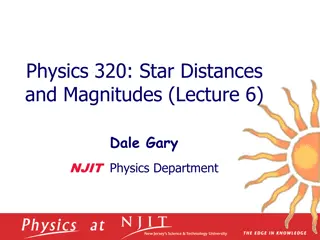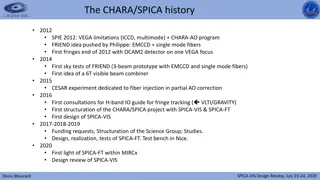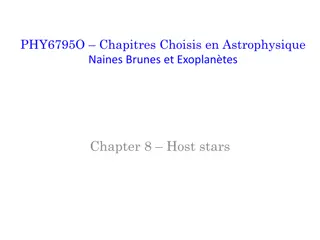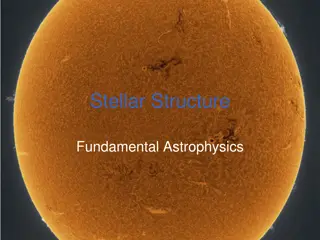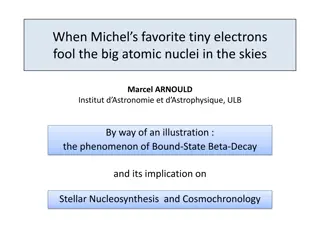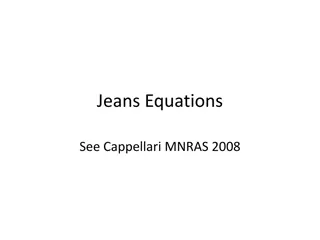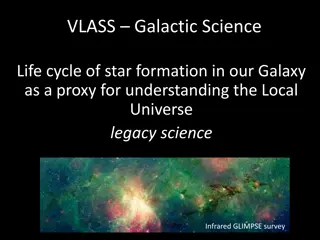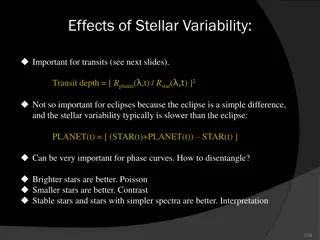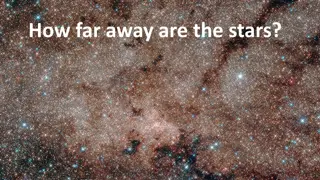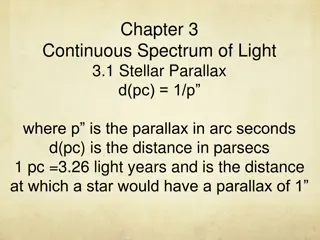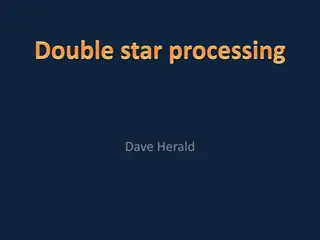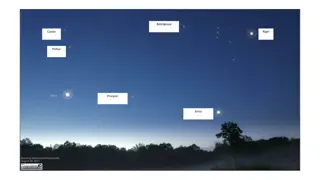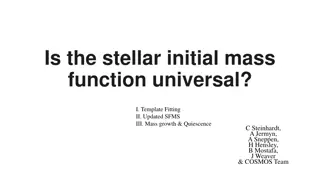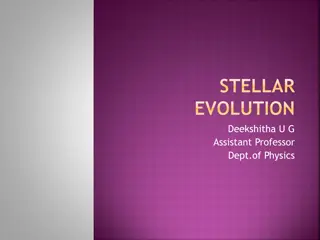Hardware Demonstration and Improvements of the Stellar Positioning System
The Hardware Demonstration and Improvements of the Stellar Positioning System (SPS) involve utilizing ancient celestial navigation techniques for lunar exploration. SPS combines central-body-relative observation with star-field observation to determine absolute position, reducing mass/power impacts
5 views • 14 slides
Slitless Stellar Spectroscopy with the SA100 Grating Procedures
Explore the world of slitless stellar spectroscopy with the SA100 grating as detailed by Anthony Harding in the ongoing creation of the Harding Spectra Library. Learn about the equipment used, the process of determining instrument response, capture procedures, and stacking techniques for obtaining s
0 views • 30 slides
Overview of Army Modeling and Simulation Office
The U.S. Army Modeling and Simulation Office (AMSO) serves as the lead activity in developing strategy and policy for the Army Modeling and Simulation Enterprise. It focuses on effective governance, resource management, coordination across various community areas, and training the Army Analysis, Mod
1 views • 8 slides
Capacity Zone Modeling for Forward Capacity Auction 17 Results
This presentation unveils the Capacity Zone modeling calculations for Forward Capacity Auction 17 associated with the 2026-2027 Capacity Commitment Period by ISO-NE PUBLIC. It delves into boundary definitions, import-constrained zone modeling, and market rules guiding the assessments and modeling pr
0 views • 16 slides
Distribution Feeder Modeling and Analysis Overview
This document delves into the modeling, optimization, and simulation of power distribution systems, specifically focusing on Distribution Feeder Modeling and Analysis. It covers the components of a typical distribution feeder, series components, Wye-Connected Voltage Regulator modeling, and equation
0 views • 14 slides
Understanding Data Modeling vs Object Modeling
Data modeling involves exploring data-oriented structures, identifying entity types, and assigning attributes similar to class modeling in object-oriented development. Object models should not be solely based on existing data schemas due to impedance mismatches between object and relational paradigm
0 views • 17 slides
Evolution of Modeling Methodologies in Telecommunication Standards
Workshop on joint efforts between IEEE 802 and ITU-T Study Group 15 focused on information modeling, data modeling, and system control in the realm of transport systems and equipment. The mandate covers technology architecture, function management, and modeling methodologies like UML to YANG generat
0 views • 16 slides
Understanding Geometric Modeling in CAD
Geometric modeling in computer-aided design (CAD) is crucially done in three key ways: wireframe modeling, surface modeling, and solid modeling. Wireframe modeling represents objects by their edges, whereas surface modeling uses surfaces, vertices, and edges to construct components like a box. Each
1 views • 37 slides
Mathematical Modeling and Error Analysis in Engineering
Mathematical modeling plays a crucial role in solving engineering problems efficiently. Numerical methods are powerful tools essential for problem-solving and learning. This chapter explores the importance of studying numerical methods, the concept of mathematical modeling, and the evaluation proces
0 views • 10 slides
Understanding Stellar Distances and Brightness in Astronomy
Exploring the methods used in astronomy to determine star distances, from stellar parallax to advanced measurements with spacecraft like Gaia. Delve into the magnitude scale and the concept of apparent magnitude in measuring star brightness.
3 views • 13 slides
Introduction to Dynamic Structural Equation Modeling for Intensive Longitudinal Data
Dynamic Structural Equation Modeling (DSEM) is a powerful analytical tool used to analyze intensive longitudinal data, combining multilevel modeling, time series modeling, structural equation modeling, and time-varying effects modeling. By modeling correlations and changes over time at both individu
0 views • 22 slides
System Modeling and Simulation Overview
This content provides insights into CPSC 531: System Modeling and Simulation course, covering topics such as performance evaluation, simulation modeling, and terminology in system modeling. It emphasizes the importance of developing simulation programs, advantages of simulation, and key concepts lik
0 views • 28 slides
Unveiling the Impact of Stellar Multiplicity on Exoplanet Detection
Exploring the effects of stellar multiplicity on exoplanet detection, this research highlights the challenges in accurately measuring Earth-sized planets and proposes high-resolution imaging as a solution. By conducting a survey of Kepler non-host stars, significant insights have been gained, sugges
0 views • 9 slides
Understanding Object Modeling in Software Development
Object modeling is a crucial concept in software development, capturing the static structure of a system by depicting objects, their relationships, attributes, and operations. This modeling method aids in demonstrating systems to stakeholders and promotes a deeper understanding of real-world entitie
1 views • 65 slides
Development of CHARA/SPICA Project for Stellar Astrophysics Research
CHARA/SPICA project history spans from funding requests to the realization of SPICA instruments, including SPICA-FT and SPICA-VIS. Scientific requirements focus on stellar physics, visible interferometry, and large surveys for stellar parameters determination, with detailed specifications for fringe
0 views • 6 slides
Understanding Host Stars and Their Importance in Exoplanet Research
Host stars play a crucial role in determining the physical parameters of planets they host, impacting exoplanet characterization and planet formation understanding. Data from astrometry, photometry, and spectroscopy, combined with stellar evolutionary models, help derive host star properties critica
0 views • 51 slides
Understanding Stellar Structure in Fundamental Astrophysics
Exploring the intriguing world of stellar structure and energy production in stars. Discover the equilibrium of forces, hydrostatic equilibrium, energy transport mechanisms, boundary conditions, equations of state, and nuclear reactions shaping the dynamics of stars. Unveil the mysteries behind the
0 views • 39 slides
Coupled Ocean-Atmosphere Modeling on Icosahedral Grids
Coupled ocean-atmosphere modeling on horizontally icosahedral and vertically hybrid-isentropic/isopycnic grids is a cutting-edge approach to modeling climate variability. The design goals aim to achieve a global domain with no grid mismatch at the ocean-atmosphere interface, with key indicators such
1 views • 21 slides
Fire and Smoke Modeling Evaluation Effort (FASMEE) Overview
FASMEE is a collaborative project aimed at assessing and advancing fire and smoke modeling systems through critical measurement techniques and observational data. Led by key technical leads, FASMEE focuses on diverse modeling areas such as fire growth, effects, coupled fire-atmosphere behavior, smok
5 views • 30 slides
Understanding Nuclear Decays and Reactions in Stellar Astrophysics
Nuclear decays and reactions, driven by weak interactions, are vital in stellar astrophysics. Various processes like bound-state beta-decay impact nucleosynthesis and cosmochronology. Specific processes in stars involve capture reactions, electron capture, and neutrino-nucleus interactions. Stellar
0 views • 22 slides
Subarea and Highway Corridor Studies: Travel Demand Modeling and Refinements
In this lesson, we delve into subarea and corridor studies focusing on travel demand model refinements, highway network coding, corridor congestion relief, and trip assignment theory. Subarea modeling plays a crucial role in forecasting travel within smaller regions with detailed traffic patterns, t
1 views • 45 slides
Understanding Jeans Equations in Stellar Dynamics
The Jeans Equations and Collisionless Boltzmann Equation play a crucial role in describing the distribution of stars in a gravitational potential. By applying assumptions like axial symmetry and spherical symmetry, these equations provide insights into the behavior of large systems of stars. Despite
0 views • 7 slides
Essential Steps for Setting up a Modeling Study
Ensure clarity on modeling goals and uncertainties. Select sample areas strategically based on interest and available data. Determine appropriate resolution for modeling. Define variables to model and validate the model effectively. Assess sample data adequacy and predictor variables availability. E
0 views • 9 slides
Exploring Star Formation and Stellar Phenomena in Our Galaxy
Delve into the fascinating realms of high mass star formation, stellar winds, planetary nebulae, and active stars through the VLASS Galactic Science project. This initiative leverages cutting-edge surveys like GLIMPSE and CORNISH to unlock the secrets of star birth, evolution, and their impact on th
0 views • 8 slides
Understanding Stellar Variability Effects in Exoplanet Studies
Exploring the impact of stellar variability on exoplanet transits and eclipses, this content delves into strategies for disentangling signals in phase curves. Factors such as stellar brightness, size, and stability play crucial roles. Illustrations and studies by Pont et al. shed light on phenomena
0 views • 7 slides
Water Storage Tanks Hydraulic Modeling and Water Quality Considerations
This presentation by Justine Carroll, P.E., Project Manager, focuses on the hydraulic modeling and water quality considerations related to water storage tanks. It covers topics such as water age evaluation, steady state modeling, extended period simulations, pump controls, demand patterns, EPS verif
0 views • 34 slides
Advancing Computational Modeling for National Security and Climate Missions
Irina Tezaur leads the Quantitative Modeling & Analysis Department, focusing on computational modeling and simulation of complex multi-scale, multi-physics problems. Her work benefits DOE nuclear weapons, national security, and climate missions. By employing innovative techniques like model order re
0 views • 6 slides
Flexible Framework for Stormwater Lids Modeling
A new flexible framework for forward and inverse modeling of stormwater lids is presented. It includes governing equations, hydraulic and contaminant transport, numerical methods, and demonstration cases for various green infrastructure components. The importance of different processes in modeling i
0 views • 20 slides
Fascinating Insights into Stellar Distances and Parallax Measurements
Delve into the vast distances between stars, such as Alpha Centauri and Proxima Centauri, captured through intriguing images. Explore the concept of parallax and its role in estimating stellar distances relative to our Sun. Understand the challenges astronomers face in measuring these immense distan
0 views • 7 slides
Understanding Stellar Properties: Distance, Brightness, and Flux
Explore the fascinating realm of stellar astronomy with topics such as stellar parallax, magnitude scales, luminosity, radiant flux, and the inverse square law. Learn about measuring distances to stars, comparing their brightness, and understanding the energy they emit into space. Dive into the intr
0 views • 31 slides
Solutions for Asteroid Location Determination in Stellar Systems
Detailed guidance is provided on how to determine the location of an asteroid in relation to stars in a stellar system. The process involves different scenarios such as unique solutions, double solutions, and four solutions, each requiring specific steps for accurate identification. Matching events,
0 views • 15 slides
Understanding Automated Speech Recognition Technologies
Explore the world of Automated Speech Recognition (ASR), including setup, basics, observations, preprocessing, language modeling, acoustic modeling, and Hidden Markov Models. Learn about the process of converting speech signals into transcriptions, the importance of language modeling in ASR accuracy
0 views • 28 slides
Understanding Stellar Brightness and Magnitude Distances
Explore the relationship between a star's brightness as observed from Earth and its actual brightness, distance, apparent magnitude, and absolute magnitude. Learn how to calculate these values using data and formulas. Gain insights into the variations in star distances, brightness, and magnitudes to
0 views • 6 slides
Implications of Star Formation in the Central Parsec of Our Galaxy with Subaru Observations
Researchers presented implications of star formation in the central parsec of our Galaxy using Subaru observations at the 2014 Subaru Users Meeting. The study focused on the supermassive black hole Sgr A* and the challenges posed by conditions in the Galactic Center for star formation. Various scena
0 views • 30 slides
Understanding the Stellar Initial Mass Function Variability
Investigating the universality of the stellar initial mass function (IMF) through template fitting and updated star-forming main sequence studies. Variable IMF models, template fitting with SED templates, and implications for star formation processes are discussed, highlighting the interplay between
0 views • 12 slides
Advanced Emission Line Pipeline for Stellar Kinematics Analysis
This comprehensive pipeline includes processes for stellar kinematics, continuum fitting, Gaussian line fitting, and analysis of SAMI-like cubes. It also covers Gaussian fitting techniques, parameter mapping, and potential issues. The pipeline features detailed steps and strategies for accurate anal
0 views • 10 slides
NetLogo - Programmable Modeling Environment for Simulating Natural and Social Phenomena
NetLogo is a powerful and versatile programmable modeling environment created by Uri Wilensky in 1999. It allows users to simulate natural and social phenomena by giving instructions to multiple agents operating independently, making it ideal for modeling complex systems evolving over time. NetLogo
0 views • 7 slides
Unveiling Dark Nebulae and Stellar Formation in Space
Dark Nebulae like the Coalsack Nebula and Snake Nebula are dense interstellar clouds where light cannot pass through. Comprised of tiny dust particles coated in frozen gases, they serve as precursors to stellar nurseries, where protostars begin to form and evolve. Learn about these enigmatic cosmic
0 views • 11 slides
Impact of M Dwarf Stellar Wind on Atmospheric Escape of a Mars-like Exoplanet
The study explores how the stellar wind from M dwarf stars affects the atmospheric escape of a Mars-like planet, focusing on the potential habitability of such exoplanets. Computer simulations utilizing stellar wind parameters provide insights into ion escape and the varying conditions at different
0 views • 19 slides
Journey of a Star: Stellar Evolution Explained
Explore the stages of stellar evolution, from the birth of a protostar in a nebula to the dramatic transformations leading to the formation of red giants, white dwarfs, and black dwarfs. Understand phenomena like gravitational collapse, temperature changes, radiative processes, and the Chandrasekhar
0 views • 7 slides









